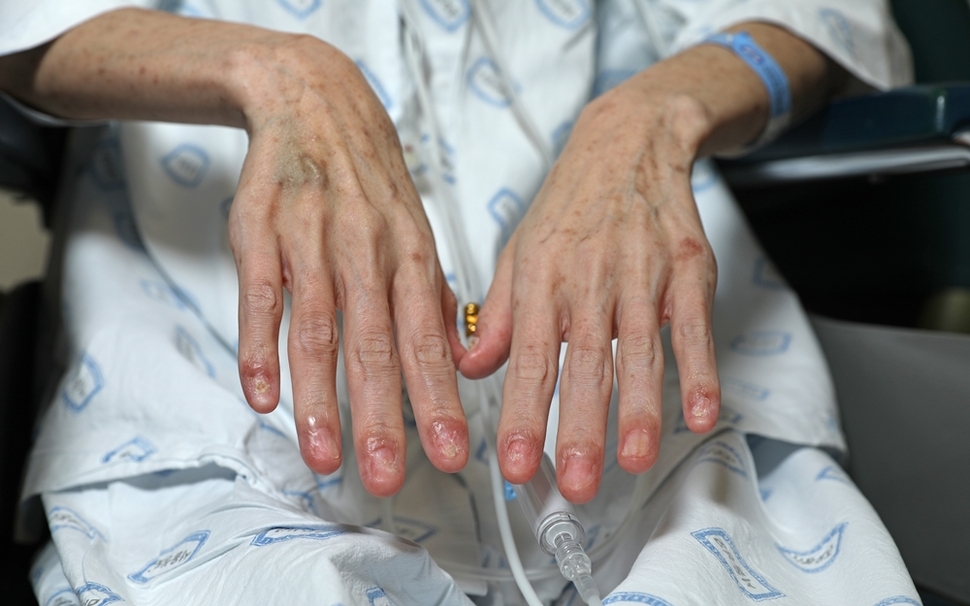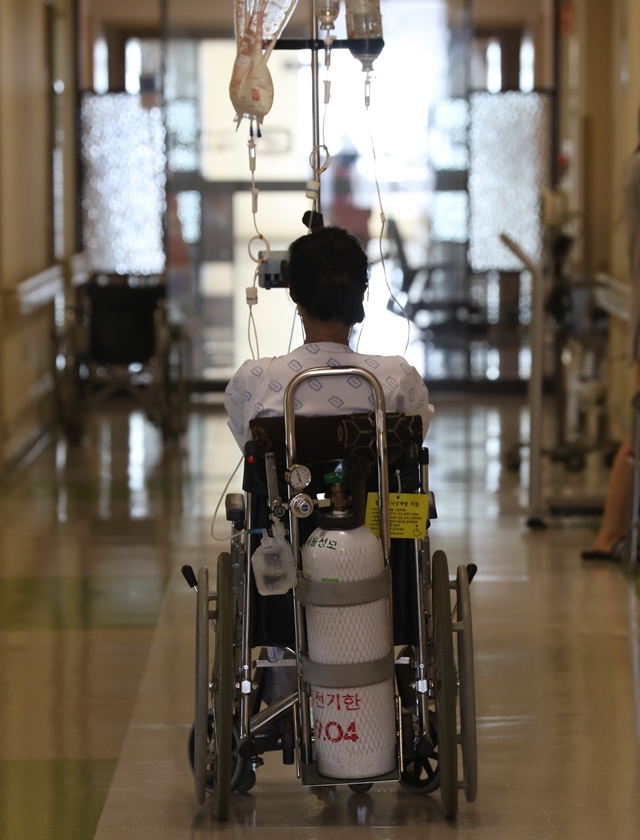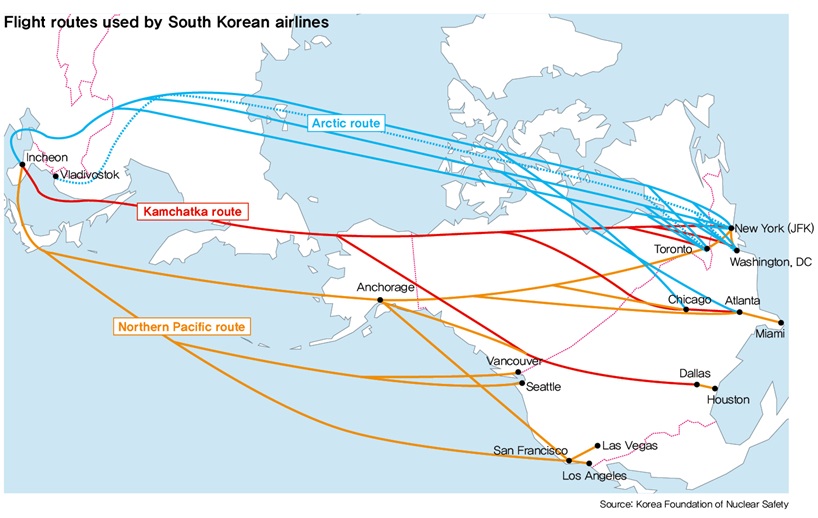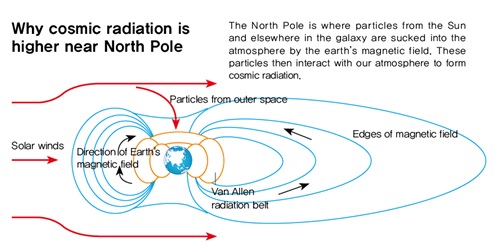 |
|
After being suffering from acute myeloid leukemia that’s likely the result of increased exposure to cosmic radiation during flights over Arctic routes for six years, K, a former flight attendant for Korean Air, is the first person to apply for industrial accident recognition for leukemia. Her deteriorating immune system has caused her nails to fall out and her skin is covered with dark spots.
|
Korean Air flight attendant’s exposure to cosmic radiation may have resulted in leukemia
Over ten years have passed since Hwang Yu-mi passed away from leukemia. Her case paved the way for numerous semiconductor workers to claim and receive industrial accident recognition for various health problems. But many cases of victimization remain unresolved. The same radiation that was one of the factors in Hwang’s illness and eventual death after working at a Samsung Electronics plant in Giheung has now been implicated in a second health crisis: one affecting the flight attendants underneath the fancy uniforms of South Korea’s airlines.
“K” is one former flight attendant who applied for industrial accident recognition for acute myeloid leukemia contracted while working for Korean Air. In addition to overtime and shift work, K claims her illness was influenced by exposure to cosmic radiation while serving on flights over polar routes for a period of six years after being hired by the airline in 2009. It is the first such application for a blood cancer case by a Korean Air flight attendant. Industrial accident applications are generally rare for conditions that do not involve injuries to the musculoskeletal system.
Other Korean Air flight attendants told The Hankyoreh that they had suffered numerous injuries and illnesses that fell outside the scope of the worker’s compensation system. Some said it was routine practice for flight attendants to use one of their days off to rest rather than treating issues as industrial accidents. The Hankyoreh met with some people who refuse to call their industrial accidents by that name – and others describing their cases as industrial accidents for the very first time.
 |
|
Once a flight attendant who graced the skies, K is now in a wheelchair. The psychological stress of recent events has brought on waves of depression.
|
The radiation dangers of the beautiful aurora
The aurora—its shimmering streams of emerald light offer the greatest spectacle in the polar regions. There are many photographers who travel to the North Pole just to take pictures of the aurora. But fewer people know that the more beautiful the aurora, the greater the radiation. The phenomenon known as the aurora is defined as the friction produced when particles from outer space are pulled into the atmosphere by earth’s magnetic field. One person who didn’t know this was K, who was a flight attendant for Korean Air. There was something else she didn’t know: the fact that an airplane can be exposed to a substantial amount of radiation when flying between 10 and 12km above the North Pole.
On a day in early July 2015, K was flying to Los Angeles. Her appetite was stunted and her lips blistered. “Looks like you’re enjoying married life!” another flight attendant said with a smile. K smiled back at her. This was the best day of her life. She had just learned that she had been selected to be an instructor at Korean Air’s training center, an extremely competitive position. She was thrilled at the idea of teaching newly hired flight attendants. But she kept getting fevers, and her whole body trembled. She was vomiting, despite not eating anything. As soon as she returned from Los Angeles, she headed to the hospital, where she was diagnosed with acute myeloid leukemia.
A woman who had once flown through the sky was now sitting in a wheelchair. When The Hankyoreh met K at Seoul’s St. Mary’s Hospital on May 26, 2018, her muscles had atrophied to the point that she can no longer walk. At a height of 173cm, she only weighs 39kg. Her bones can be seen under her skin. Her lips are completely shriveled, and her hair is gone. Her skin is discolored, with dark splotches here and there, and her back is red with peeling skin. K received a bone marrow transplant as part of the treatment regimen for her leukemia, and one of the complications was a chronic case of graft versus host disease. K did not want her real name or photograph to be made public.
“The most upsetting thing is that I don’t get to enjoy married life,” K said. Her illness struck eight months into her marriage, and she spent the majority of those eight months on a plane. Most of her married life has been spent fighting the disease. K’s husband took a leave of absence from his job in April and has been looking after her ever since. “My wife was really pretty,” he said, showing me an older photograph. He was not wrong.
K had liked flying. The uniforms looked good, and she enjoyed meeting people. “My job would take me to places like Paris and New York. It was the perfect fit for my personality,” she said. Even now, she dreams of flying. “I ask myself, why am I flying again, after I left my job? What’s going on? I get all excited and then I wake up, and it’s a dream.” She still can’t stop thinking about being a flight attendant.
K had not wanted to quit, but in the end she was forced out. After using over 90 days of her yearly vacation and sick leave, she had taken a one-year leave of absence. But even though her leave was far from over, company staff started calling her several times a day. To be reinstated in her position, she was told, she had to bring in a doctor’s note saying she would have no trouble working as a flight attendant. She would have to drop by the office and have an interview with so-and-so. Could she handle it? What was she going to do? “They were telling me to resign, without actually using that word,” she said. K barely managed to visit the company and extend her leave for three months. But her health deteriorated as she contracted pneumonia, and she ultimately quit in Feb. 2017.
 |
|
Flight routes used by South Korean airlines
|
Personnel used up and thrown away by Korean Air
“This company is really awful,” K said, her voice wheezing. Because of severe lung damage, she was wearing an oxygen mask. “No matter how hard you work and how much they praise you, when you’re no longer useful they throw you away.” The corners of her eyes were red – not from sadness, but because of severe dry eye syndrome, resulting from her tear ducts drying up. Throughout the interview, she kept putting in eye drops. There are many things that K lacks – tears, spit and fingernails. Her chemotherapy and graft versus host disease have destroyed all the body parts that rely on rapid cell division. The most heartbreaking loss of all was her ovaries. Her doctor told her that she was basically incapable of having a child. Her feeling of betrayal by the company motivated her to ask the government to recognize her disease as a work-related condition.
K contends that the outbreak of leukemia is connected with her work as a flight attendant. There is no history of the condition in her family, and there had been no abnormalities in her previous health checkups. “Flight attendants are exposed to a significant amount of cosmic radiation on airplanes, which results in a higher risk of leukemia and other forms of cancer. I believe there is a considerable causal relationship between K’s work and the occurrence of her condition,” wrote Kang Mo-yeol, a professor of occupational and environmental medicine at Seoul St. Mary’s Hospital, in an opinion assessing the occupational correlation with K’s disease.
Kim Seung-hyeon, a labor attorney with a law firm called Siseon who is handling K’s industrial accident application, explained that the application had been sent to the Korea Workers' Compensation and Welfare Service by registered mail on June 11.
Cosmic radiation exposure for flight attendants exceeds that of many nuclear plant workers
It is a little-known fact that flight attendants generally are exposed to more radiation than workers at nuclear power plants. When the Korea Foundation of Nuclear Safety analyzed the radiation to which flight attendants at South Korean airlines were exposed during 2015, the average radiation exposure for flight attendants in the passenger cabin was 2.2 millisieverts (mSv). This was higher than the levels for nondestructive testers who deal with radiation (1.7mSv) and workers at nuclear plants (0.6mSv). By way of reference, the yearly dosage limit for the general public is 1mSv.
But 2.2mSv is only the average value. “The notable thing about this survey is that a considerable number of flight attendants are distributed in the yearly dosage range of 3mSv to 4mSv. The range with a small yearly dosage of radiation includes flight attendants who are on leave and those who generally serve on domestic flights,” said a spokesperson for the Korea Foundation of Nuclear Safety.
Exposure to radiation is particularly high at Korean Air. According to a report on the results of a 2017 survey of safety management for radiation in the natural environment that was released by the Nuclear Safety and Security Commission (NSSC) in Feb. 2018, the cabin crew at Korean Air is exposed to an average of 2.88mSv a year, the highest of any South Korean airline. The reason is that Korean Air runs more routes than other airlines and frequently flies over the North Pole. This is the route used by planes returning to South Korea from cities on the east coast of the US and Canada such as New York, Washington, Chicago, Atlanta and Toronto.
The North Pole is the part of the earth that is bombarded with the most cosmic radiation. By its very nature, the North Pole is where particles from the Sun and elsewhere in the galaxy are sucked into the earth’s atmosphere by the earth’s magnetic field. Radiation at the North Pole is two to four times higher than at the equator. Furthermore, radiation also increases sharply at higher altitudes. Every time flight attendants fly on the North Pole route, they are exposed to as much radiation (0.1mSv) as if they were getting their chest X-rayed. From the time that K joined Korean Air in Oct. 2009 until she came down with the disease in July 2015, she flew 5,518 hours in various parts of the world, including the Americas, Asia and Europe. The area where she flew the most was in the US, for a total of 1,776 hours.
While K was working, she was not aware that the North Pole route was dangerous. “I just had some vague idea that it probably wasn’t healthy. When I was on the polar route, I would get a headache and feel dizzy. I would joke with the other flight attendants about being zapped by radiation, but I didn’t think it was serious,” she said.
Law requires airlines to inform flight attendants of radiation risks
 |
|
Annual levels of radiation exposure for South Korean flight attendants
|
K never checked her level of radiation exposure. According to Article 10 of the Act on Safety Management for Radiation in the Natural Environment, airlines are required to provide flight attendants with information about radiation exposure on an individual basis. When I read the legal statute to K, she was shocked. “Wow, does it really say that? Goodness, I’d never heard of that before!” When I told K I had heard from Korean Air that information about individual radiation exposure was available at the company’s aviation medical center, she was even more shocked. “Are we talking about Korean Air? No one knows about this. Just try asking any flight attendant.”
The airline flight attendant safety management guidelines devised by the Nuclear Safety and Security Commission (NSSC) are even more specific: “1. Air transport operators shall ensure that flight attendants are well-informed about matters including the altitude at which they can be exposed to cosmic radiation, the radiation dosage rate for each degree of latitude and longitude, the actual hours flown in these areas and the results of an assessment of the amount of radiation exposure. 2. Air transport operators must notify flight attendants about the amount of cosmic radiation to which they have been exposed, and flight attendants must check their individual radiation exposure.” Hankyoreh 21 contacted more than ten other flight attendants, but none of them knew their radiation exposure or a way to check it.
Research is still underway about exactly how high the cancer incidence rate is among flight attendants who have been exposed to cosmic radiation. A survey of flight attendants in Northern Europe and the US found that they have a higher incidence of breast cancer, skin cancer, prostate cancer, acute myeloid leukemia and brain cancer than the average person.
Potential effects of cosmic radiation
 |
|
Why cosmic radiation is highest near North pole?
|
Cosmic radiation has unique characteristics that can have a different effect than radiation at the surface of the earth, even at the same amount of exposure. “On the surface, people are generally exposed to a high amount of radiation for a brief time, but flight attendants are exposed to a low amount of radiation for a long time. In addition, cosmic radiation is much more complex in its composition than surface radiation. In particular, cosmic radiation contains a lot of neutrons, and a single neutron has a bigger effect on cells than other kinds of radiation. I think a different approach is needed in regard to the amount of radiation that flight attendants are exposed to,” said Lee Jae-jin, a scholar in the solar and outer space environment group at the Korea Astronomy and Space Science Institute.
Korean Air’s position is that its flight attendants are not exposed to excessive radiation levels and that they are managed so as to keep that exposure below the legal standard. The Act on Safety Management for Radiation in the Natural Environment states that flight attendants cannot be exposed to more than 50mSv of radiation in any one year (or 100mSv over five years), while the safety management guidelines for radiation in the natural environment recommend that yearly exposure not exceed 6mSv, in line with EU standards. Korean Air’s company policy also sets the maximum at 6mSv.
“When a flight attendant’s accumulated radiation exposure over one year exceeds 5mSv, we adjust their flight schedule so that the exposure does not exceed 6mSV,” said a spokesperson for Korean Air. An agreement between labor and management states that flight attendants will not pass over the North Pole route more than three times in one month.
“We do not make radiation exposure public in order to protect flight attendants’ privacy. Instead, we take the opportunity at every online and offline training session to let them know that they can check their individual radiation exposure at the aviation medical center,” the spokesperson said.
Other risks faced by flight attendants
 |
|
Average annual radiation exposure for employees in various industries (2015)
|
Cosmic radiation was hardly the only factor that may have affected K’s medical condition. There was the additional radiation she was exposed to each time she was X-rayed while going through security; working on the night shift, which is considered a Group 2 carcinogen by the International Agency for Research on Cancer; the irregular working hours that disrupt biorhythms; the dirty air in the cabin; and the emotional demands of working in the service sector. There was also an outcry over recent reports that Group 1 carcinogens were being used to clean the interior of Korean Air airplanes.
But there is still a long way to go before the government recognizes K’s condition as being work-related, which will require establishing a considerable causal relationship between her work and her condition. After K resigned, she was hit with depression because of her increasing psychological stress. Other sources of stress are the fact that she is challenging Korean Air and that this is the first time that the South Korean government has been asked to recognize leukemia resulting from cosmic radiation as a work-related condition.
“I feel like I’m walking on eggshells,” said K’s husband, as he looked at his wife, anxious about when her heart might break.
K hopes that other flight attendants will join her struggle. “There are a lot of sick people at Korean Air, people with breast cancer, leukemia, lymphomas, lung cancer, cancer of the thyroid gland and cancer of the larynx. I’m discreetly asking around about them. Korean Air isn’t going to open up about an uncomfortable topic like this. Getting recognition for a work-related condition is my right, and I want to exercise that right,” she said.
By Byeon Ji-min, Hankyoreh 21 staff writer
Please direct comments or questions to [english@hani.co.kr]















